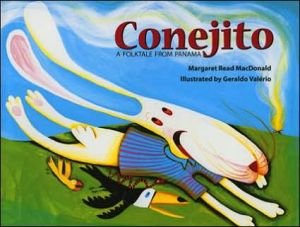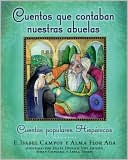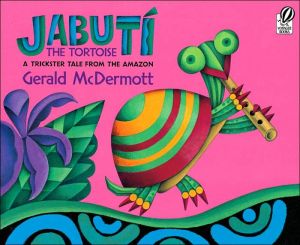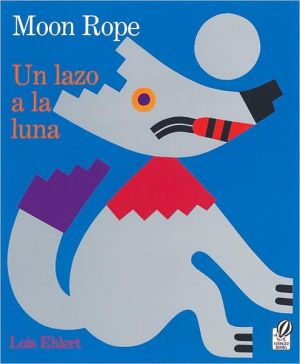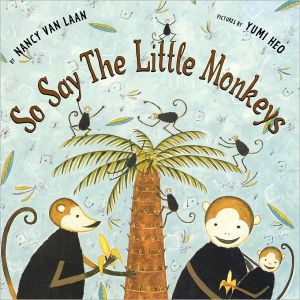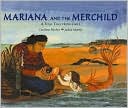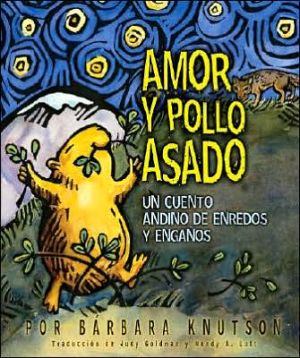Conejito: A Folktale from Panama
An all-star author-illustrator team delivers a timeless story about finding love and acceptance.
Search in google:
An all-star author-illustrator team delivers a timeless story about finding love and acceptance.Publishers WeeklyThe title hero (whose name means "Little Rabbit") is off to visit his aunt in the mountains. "I have a sweet old auntie,/ my T a M nica!" sings Conejito. "And when she goes out dancing... / they all say, `Ooo la la!' " He encounters three predators but escapes by promising them he'll be tastier on the way back: "[T a M nica] is going to feed me cakes and cookies and every good thing/ until I am Gordito! Gordito! Gordito!" But his aunt is clever, too, and after plumping up Conejito (with fruits and vegetables as well as sweets), she stuffs him into a barrel so he can roll past the danger and back to Mam . MacDonald's (Fat Cat) text, with its giddy, kick-up-your-heels feel, presents a wealth of audience participation opportunities. She's chosen 13 expressive Spanish words and phrases to punctuate the story, and repeats them judiciously throughout. The text also boasts several refrains in addition to the T a M nica song (which can be sung using the melody on the final page). But Valerio's (Do You Have a Hat?) pictures are not quite as successful. The book's elongated format seems ideal for the extended curvilinear lines he favors (the rabbits' ears often take up half the spreads), and the illustrations featuring the rabbit family take the best advantage of the layout. But the almost maniacal energy of the other scenes, coupled with a scattered compositional focus, often makes it difficult to know where to look first. Ages 4-8. (Apr.) Copyright 2006 Reed Business Information.
\ Publishers WeeklyThe title hero (whose name means "Little Rabbit") is off to visit his aunt in the mountains. "I have a sweet old auntie,/ my T a M nica!" sings Conejito. "And when she goes out dancing... / they all say, `Ooo la la!' " He encounters three predators but escapes by promising them he'll be tastier on the way back: "[T a M nica] is going to feed me cakes and cookies and every good thing/ until I am Gordito! Gordito! Gordito!" But his aunt is clever, too, and after plumping up Conejito (with fruits and vegetables as well as sweets), she stuffs him into a barrel so he can roll past the danger and back to Mam . MacDonald's (Fat Cat) text, with its giddy, kick-up-your-heels feel, presents a wealth of audience participation opportunities. She's chosen 13 expressive Spanish words and phrases to punctuate the story, and repeats them judiciously throughout. The text also boasts several refrains in addition to the T a M nica song (which can be sung using the melody on the final page). But Valerio's (Do You Have a Hat?) pictures are not quite as successful. The book's elongated format seems ideal for the extended curvilinear lines he favors (the rabbits' ears often take up half the spreads), and the illustrations featuring the rabbit family take the best advantage of the layout. But the almost maniacal energy of the other scenes, coupled with a scattered compositional focus, often makes it difficult to know where to look first. Ages 4-8. (Apr.) Copyright 2006 Reed Business Information.\ \ \ \ \ Children's LiteratureThis book is an amusing folktale from Panama that will be enjoyed by children everywhere. Conejito is a small bunny that is being sent to visit his aunt high in the mountain. While he is there he is to eat her cakes and cookies so he will become, "Fat! Fat! Fat!" On this journey Conejito runs into a fox, a tiger, and a lion. Each of these animals wants to eat him for lunch, but Conejito convinces them that he is skinny now and that they should wait until he comes down the mountain, fat. Each agrees and Conejito continues his journey until he finally reaches his aunt's home. Children will delight at learning how Conejito outsmarts the fox, lion, and tiger on his way home to his mother. The story has great illustrations that are colorful, fun, and exaggerated. In the corners of the pages, the illustrator has included three small jungle inhabitants that have nothing to do with the story, but seem to be following Conejito on his trip. I found them absolutely delightful, plus they add extra interest to the pictures. The author has included a pronunciation key at the end of the book. This picture book can easily be read aloud as well as read alone by an early reader. This folktale will be enjoyed by both boys and girls and would make a wonderful gift. 2006, August House Publishers, Ages 4 to 8. \ —Kathie M. Josephs\ \ \ School Library JournalK-Gr 4-Based on a folktale from Panama, this lively retelling has a delightful blend of Spanish and English. MacDonald skillfully provides word meanings in context, as in this example: Conejito is told by his Mama that when he visits T'a M-nica, "She will feed you cakes and cookies and every good thing-until you are aGordito! aGordito! aGordito! Fat! Fat! Fat!" The plot skips along predictably as Conejito meets and tricks Se-or Zorro (Mr. Fox), Se-or Tigre (Mr. Tiger), and Se-or Leon (Mr. Lion). Children will eagerly join in singing Conejito's song: "I have a sweet old auntie,/my T'a Monica!/And when she goes out dancing-/they all say `Ooo la la!'" Valerio's full-color acrylic illustrations stretch across each spread, reflecting a folk-art motif that perfectly complements the story. Movement and energy are captured in the animated characters. A pronunciation guide and an author's note giving the source for both the story and song are helpful additions. This book is sure to encourage participation. It begs to be read aloud with a group.-Lee Bock, Glenbrook Elementary School, Pulaski, WI Copyright 2006 Reed Business Information.\ \ \ \ \ Kirkus ReviewsMacDonald weaves context-translated Spanish and a simple campfire song into this easy-to-learn tale of a young rabbit who outwits three predators with some help from his canny Auntie. Bounding up the mountain to grow, "¡Gordito! ¡Gordito! ¡Gordito!" on Tia M-nica's cakes and cookies, Little Bunny encounters Se-ors Zorro, Tigre and Le-n. Putting them off with a promise that he'll be much fatter coming back down, Conejito eats and dances with Tia M-nica until he's "healthy and strong and fat as a butterball!"-whereupon Tia M-nica pops him into a barrel and sends him rolling safely home. Valerio uses warm colors in the full bleed illustrations, s-t-r-e-t-c-h-i-n-g out the ears and tails of his rubbery figures to create a sense of exuberant motion. A lively, and less violent, variation on Betsy Bang's Bengali version, The Old Woman and the Red Pumpkin (1975), illustrated by Molly Garrett Bang. (source note) (Picture book/folktale. 6-8)\ \
